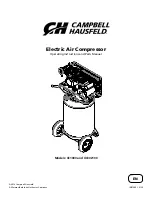
20
1310 3011 08
4.5
Oil And Oil Filter Change
Fig. 4.2 Oil filters
4.5.1
Engine Oil And Oil Filter Change
Consult also the Engine Operators Manual for oil and oil filter
(1) change intervals.
4.5.2
Compressor Oil And Oil Filter Change
The quality and the temperature of the oil determine the oil
change interval.
The prescribed interval (See section 4.2) is based on an oil
temperature of up to 100 ºC (212 ºF) and normal operating
conditions.
When operating in high ambient temperatures, in very dusty or
high humidity conditions, it is recommended to change the oil
more frequently.
+
In this case, contact Atlas Copco.
1
Run the compressor until warm. Close the outlet valve(s)
and stop the compressor. Wait until the pressure is
released through the automatic blow-down valve.
Unscrew the oil filler plug (2) one turn. This uncovers a
vent hole, which permits any pressure in the system to
escape.
2
Drain the oil by removing all drain plugs. Drain plugs are
located at the oil tank, discharge manifold, and oil
injection manifold. Catch the oil in a drain pan. Screw
out the filler plug to speed up draining. Tighten the plugs
after draining.
3
Remove the oil filter (3), e.g. by means of a special tool.
Catch the oil in a drain pan.
4
Clean the filter seat on the manifold, taking care that no
dirt drops into the system. Oil the gasket of the new filter
element. Screw it into place until the gasket contacts its
seat, then tighten one half turn only.
5
Fill the air receiver until the pointer of the oil level gauge
(4) registers in the upper extremity of the green range.
Take care that no dirt drops into the system. Reinstall and
tighten the filler plug.
6
Run the unit at no load for a few minutes to circulate the
oil and to evacuate the air trapped in the oil system.
7
Stop the compressor. Let the oil settle for a few minutes.
Check that the pressure is released by opening an air
outlet valve (5). Screw out filler plug (2) and add oil until
the pointer of the oil level gauge (4) again registers in the
upper extremity of the green range. Reinstall and tighten
the filler plug.
ù
ù
Never add more oil. Overfilling results in oil
consumption.
4.6
Cleaning Coolers
Keep the coolers clean to maintain the cooling efficiency. The
fan side surface of compressor and engine cooler is accessible
by opening cooler acces doors.
ù
ù
Remove any dirt from the coolers with a fiber
brush. Never use a wire brush or metal objects.
Then clean by air jet in reverse direction of normal flow.
If the dirt is oily, wash the coolers with degreaser or a
cleansing agent.
ù
ù
Protect the electrical and controlling equipment, air
filters etc. against penetration of moisture.
A spray gun should preferably be used to apply the solvent to
the fins. Rinse the blocks by means of a water jet max. 100
psi at 2 inch distance after a soaking-in period. Steam
cleaning may also be applied.
ù
ù
To avoid damaging the coolers, angle between
waterjet and coolers should be approx. 90º.
Close the service door(s).
ù
ù
Never leave spilled liquids such as fuel, oil, water
and cleansing agents in or around the compressor.
4.7
Battery Care
+
Before handling batteries, read the relevant safety
precautions and act accordingly.
An ASB (Service Bulletin) dealing elaborately with batteries
and due care is available on request.
If the battery is still dry, it must be activated as described in
point 4.7.1.
The battery must be in operation within 2 months from being
activated; if not, it needs to be recharged first.










































